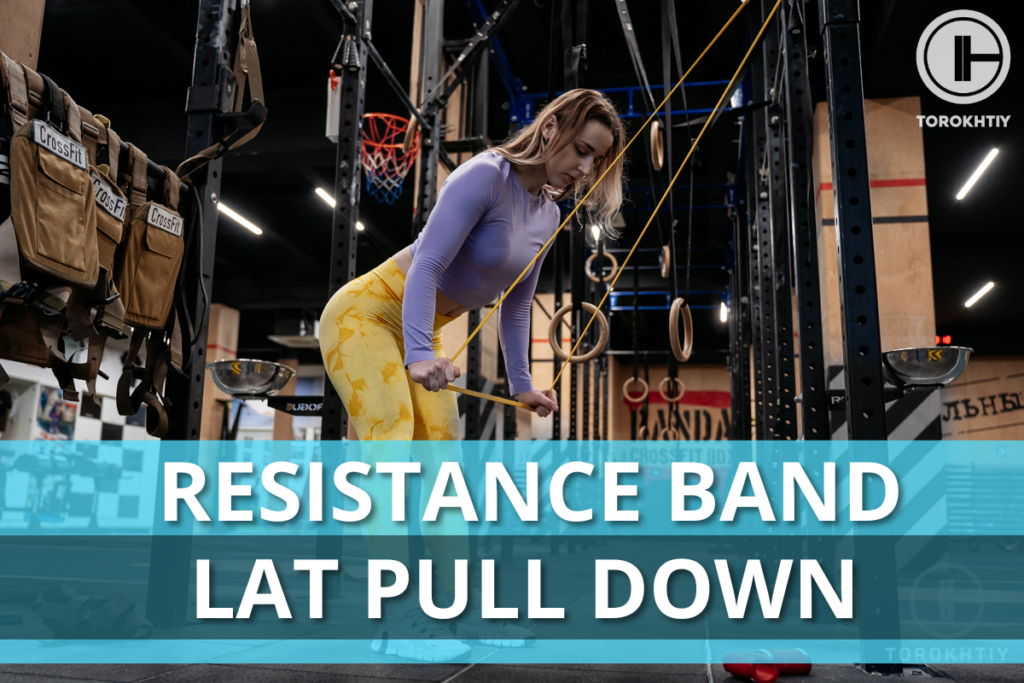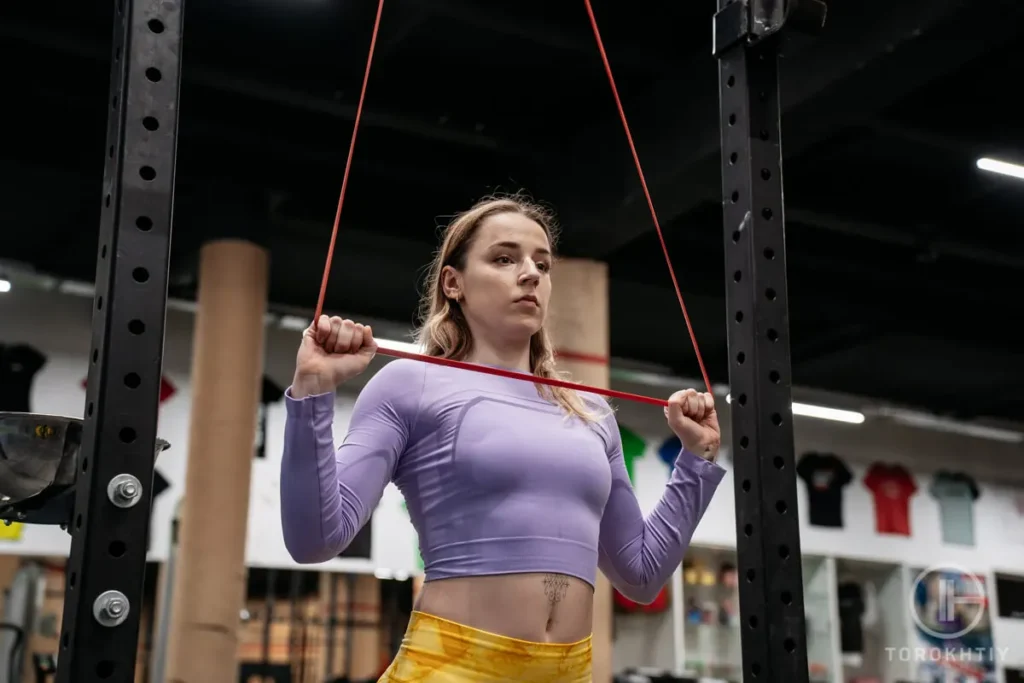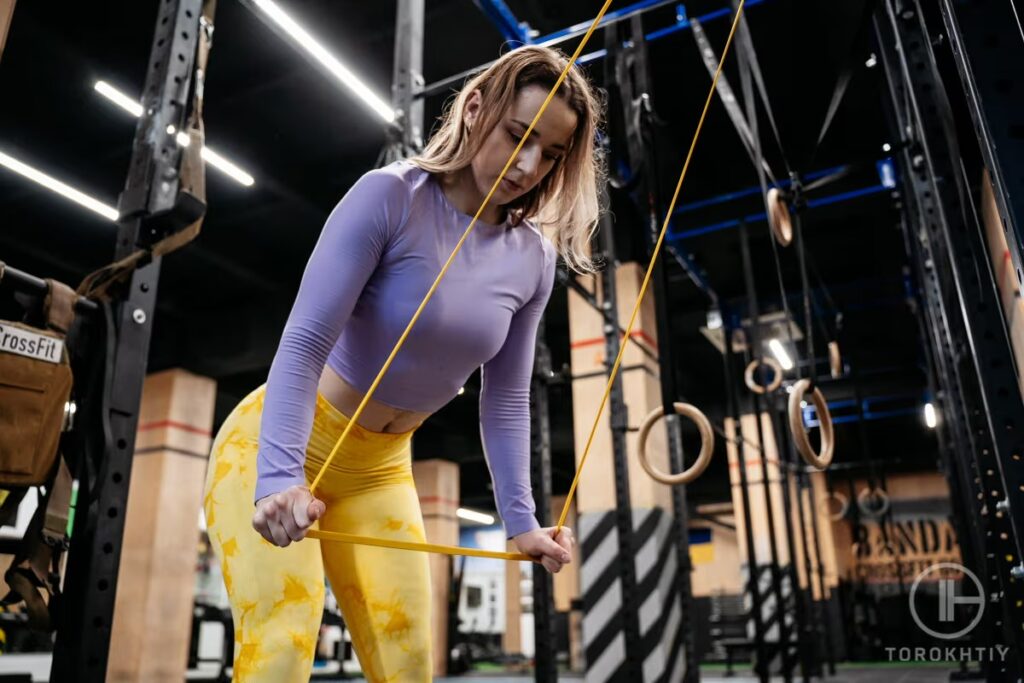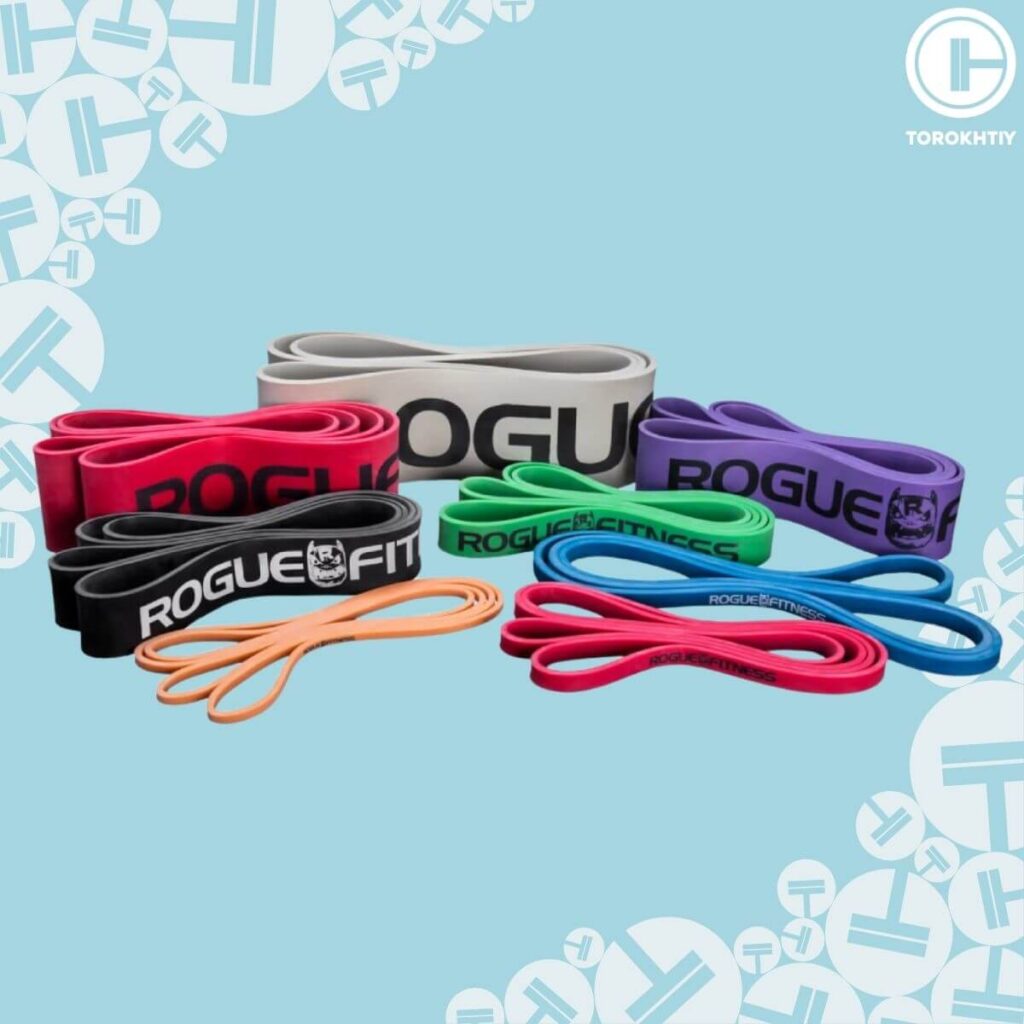Resistance Band Lat Pull Down: Detailed Guide
Author:
Unlock your full potential by engaging with our experts and community! Have questions about your fitness journey or looking for expert advice on weightlifting techniques? Don’t hesitate — leave a comment below and Tanya Shaiko will provide a personalized answer and insights to help you reach your goals.
Torokhtiy is reader-supported. Some links are affiliate links, and we may earn a commission at no extra cost to you. See our disclosure page for details.
With pulldowns widely believed to be one of the best back-building exercises, resistance band lat pulldown offers an excellent exercise alternative that can be easily performed at home or on the go.
With many gyms across the world closing, more people are looking for alternative ways to exercise at home. Whilst most people think of the lat pulldown cable machine when wanting to build bigger lats, it’s not the only option.
Several lat pulldown exercise variations can be done at home, with the lat pulldown with bands providing a convenient, low-cost lat pulldown option when performed with the correct technique.
To clear up any confusion, I’ve provided an in-depth guide into the resistance band lat pulldown below. Let’s look at it in more detail.
Resistance Band Lat Pulldowns – Banded lat pulldowns provide a convenient, versatile compound exercise option with several suitable variations. Muscles worked include the latissimus dorsi and teres major alongside several secondary movers.

How to Do Lat Pulldowns With a Band?
The latissimus dorsi (lat) muscles are big muscles located in your middle and lower back area, connecting your arms to your spine. Their functions include:
- Reinforcing correct posture
- Protecting and stabilizing your spine
- Providing strength for shoulder and back movements
The resistance band lat pulldown is one of the best exercises to improve posture and strengthen your back muscles. It’s also fairly easy to perform once you understand the correct movement.

Muscles Worked by Resistance Band Lat Pulldowns
The resistance band lat pulldown is a compound exercise that targets a range of muscle groups. Primary muscle groups worked include the:
- Latissimus Dorsi (the largest muscle in the back)
- Teres Major (muscles near the bottom of the shoulder blades)
Secondary muscles worked include the:
- Posterior Deltoids (muscles at the back of the shoulders)
- Trapezius and Rhomboids (upper and middle back musculature)
- Bicep Brachii (upper arm muscles)
- Brachialis and Brachioradialis (forearm muscles)
How to Do the Banded Lat Pulldown Correctly (Step-By-Step Guide)?
Step 1: Equipment
Before setting up, make sure you have a suitable resistance band (with or without handles), and a high anchor point to secure the band to (door frame, hook, gym equipment)

Step 2: Starting Position
To start, attach the resistance band to a suitable elevated anchor point, using the middle of the band as the contact area. Once the band is correctly attached, assume a shoulder-width floor position under the band (this can be standing, kneeling, or sitting depending on the band height)
Next, extend your arms upwards and hold the band. If your band doesn’t have handles, make sure your palms are facing forward with your hands a little wider than shoulder-width apart. If you have handles, take them in the normal position.
Step 3: Movement Pattern
Brace your core musculature and pull the band down until it reaches chest height, keeping your elbows flexed and shoulder blades back
Pause briefly, squeezing your lat muscles whilst keeping your core braced. Throughout the movement, keep your chest up and your head looking forward. Avoid shrugging your shoulders, arching your back, or swinging your torso throughout the movement.
3 Common Lat Pulldown With Bands Mistakes
❌ Using Body Momentum
If you’re using body momentum to bring the bands toward your chest, you’re likely using too much resistance. If you notice your body moving, lower the band resistance and focus on keeping a neutral back throughout the whole movement.
Alongside lowering the chance of injury, this allows you to work the target muscles more, leading to more muscle gains.
❌ Performing the Wrong Movement
A common mistake when performing a lat pulldown with resistance bands is using your arms to pull the bands towards you rather than your lats as the prime movers.
With this, the lat pulldowns become an arm exercise and take away the stress from your back. Focus on flexing your elbows whilst keeping your shoulders drawn back and tension your lat muscles. This also allows you to develop a better mind-muscle connection.
❌ Doing Partial Reps
With the band tension increasing as the band stretches, it’s common to see lifters performing partial reps when the band gets difficult to pull more.
If this happens, reduce the band tension and focus on completing fewer reps with better form rather than sacrificing form for more reps.

7 Benefits of Resistance Band Lat Pulldown Loop
✅ Convenience
Compared to other lat pulldown variations, resistance band pull downs can be performed anywhere with little set-up time or equipment required. If you have access to a resistance band, you can perform banded pulldowns when traveling, at work on a break, or in your home gym.
✅ Portability
Compared to the cable pulley and lat pulldown machines, resistance bands can be easily folded up and stored in your gym bag. Gym equipment often takes hours to take apart and a lot of effort to transport to different locations, making banded lat pulldowns an excellent option in terms of portability.
✅ Cost
Whilst most gym equipment is designed to last for years up to a lifetime, it can also become quite expensive meaning cost needs to be factored in when choosing the right purchase.
Whatever cable pulley machine you choose for your home gym set-up, it’s likely to be a lot more expensive than a pair of durable resistance bands that are also designed to last.
✅ Resistance
With banded lat pulldowns, the resistance gets harder as you pull the bands closer to your body and away from the anchor point. At the bottom of the movement when your hands are closer to your chest, the band tension is at max capacity, allowing you to squeeze your lat muscles tightly.
✅ Exercise Variations
Resistance band lat pulldowns have several exercise variations that can be performed by changing the exercise band, hand and body position, and movement pattern. With so many different variations, the banded lat pulldown can be personalized according to your goals and exercise preferences.

✅ Posture
The banded lat pulldown is one of the most effective exercises if you’re looking to improve your posture. If your job involves sitting for a long time, your slouched shoulder position will likely lead to shoulder and back pain over time.
By learning to draw the shoulder blades back and activate the smaller, underutilized back muscles, banded lat pulldowns help to teach the correct posture and alleviate common back and shoulder pain.
✅ Rehabilitation
Performing a lat pulldown with bands at home or in the gym gives you the freedom to move your joints along planes of motion that are most comfortable. This makes them ideal for people with reduced joint mobility or needed to perform rehabilitation after an injury.
3 Variations of Banded Lat Pulldowns
Here are some good exercise variations if you want to perform the banded lat pulldown at home or in the gym:
Follow us!

Free!
Get a 2-week Weightlifting Program as a bonus for the subscription to kickstart your training plan!

Free!
1. Straight Arm Lat Pulldowns
To perform straight arm lat pulldowns, start with the same set-up as normal banded lat pulldowns, attaching the middle of the band to a high anchor point.
Assume the correct body position and grab the bands with straight arms and palms facing down. Whilst tensing your lats, pull the bands straight down as far as you can whilst keeping your arms straight.
Throughout the movement, make sure to keep a neutral back position whilst slightly bent over, keeping your arms stretched out and core tensed. Squeeze your lats at the bottom of the movement and return to your starting position in a controlled fashion.
2. One-Handed Large Loop Band Lat Pulldowns
One-handed large loop band lat pulldowns are perfect for those who have asymmetrical lats or are just looking for a different banded exercise variation.
Start by securing the loop band to an elevated anchor point and assuming the correct body position using the guide above. Loop your hand through the middle of the large loop band and grasp it firmly whilst making sure your hand is facing towards you.
To perform normal banded large loop late pulldowns using one hand, pull the band down towards your chest whilst flexing the same elbow. If you’re performing straight-arm pulldowns, use the same technique cues discussed above but use one arm.
Make sure to repeat with each arm whilst keeping the hand controlled at all points of the movement.
3. Lying Lat Pulldowns
Instead of using a high anchor point, attach a band to a lower anchor point using a door, hook, or gym equipment.
Using a mat, lay down on the floor with your head facing the anchor and your arms stretched out towards the band. Grip each handle or the middle of the loop band if you’re not using handles.
Pull the handles away from the anchor point and focus on getting your hands level with your chin whilst flexing your elbows outwards. Keep your head and shoulders down. If you can’t perform the full movement using just your lats, lower the resistance band.
How to Choose the Best Resistance Band for Lat Pulldowns?
When choosing a resistance band, make sure to consider these important factors before purchasing:
- Consider the material type and if you have any skin allergies
- Decide what you want to use the bands for and if you need to attach different accessories.
- Check that the bands offer enough resistance (max and range)
- Make sure the bands are small enough to be stored away and fit in your gym bag
Rogue Echo resistance bands
Rogue is well-known for producing high-quality, durable workout accessories at reasonable price points.
Offering 5-200 lbs of resistance in eight color-coded band options, the Rogue Echo Resistance Bands are made from natural rubber latex that’s constructed in layers to stop the bands from wearing down or snapping.
At 41″ long, the resistance bands offer the perfect length for a wide range of versatile uses including as a lat pulldown banded alternative with or without handles. With the flat and wide design, the Rogue Echo bands can easily be stored away or carried around in your gym bag without taking up much space.

Overall, the Rogue Echo resistance bands are an excellent band option if you’re looking for a durable, high-quality set of resistance bands made by a proven exercise equipment brand.
FAQ
What is an alternative to lat pulldowns?
If you’re not able to do lat pulldowns due to a lack of equipment or mobility issues, there are many suitable alternative exercises that work similar muscle groups.
Inverted rows offer a similar movement pattern that the same muscle groups. Other alternatives include bent-over rows, dumbbell rows, and decline dumbbell pullovers.
How can I lat pull without a machine?
If you don’t have access to a lat pulldown machine, don’t worry. There are plenty of suitable ways to work the same muscle groups. Resistance band lat pulldowns offer a great alternative that can provide as much resistance as you need to overload the target muscle groups.
Can pull-ups replace lat pulldowns?
Both pull-ups and lat pulldowns are classed as compound movements that work the same muscle groups. The movement for both exercises is very similar, with pull-ups recruiting more core musculature when trying to stop the body from swinging.
Pull-ups can provide a good replacement for lat pulldowns, but ideally both should be done as part of a varied and periodized training program.
Conclusion
With the popularity of home gyms increasing, resistance band lat pulldowns offer a great exercise alternative to a traditional pulldown machine. To perform the lateral pull down with bands correctly, follow the steps I’ve outlined above and avoid the common mistakes that many gym-goers make.
There are many suitable banded lat pulldown variations including straight arm pulldowns and lying lat pulldowns. One-handed large loop lat pulldowns provide an excellent exercise option to work on muscular imbalances.
Have you done resistance band lat pulldowns before? What exercise variations do you like? Let’s discuss them down below!
Also Read:
- Barbell Deadlift With Resistance Bands
- Resistance Band Deadlift
- Best Pull Up Assist Bands
- Bicep Exercises With Resistance Bands
- Gym Bag Guide
- Ultimate Lat Pulldown Machine Guide
- Resistance Bands Guide
References:
- The Anatomy of the Latissimus Dorsi Muscle // Verywell Health: https://www.verywellhealth.com/latissimus-dorsi-muscle-anatomy297067.html
- How to Do the Lat Pulldown // Healthline: https://www.healthline.com/health/fitness/lat-pulldown.html
- Banded Lat Pulldown at Home // Fitness Drum: https://fitnessdrum.com/banded-lat-pulldown.html
- Inverted Rows Are More Effective Than You Think // Healthline: https://www.healthline.com/health/fitness/australian-pull-up.html
- Photos made by Torokhtiy Media Team
Why Trust Us?
With over 20 years in Olympic weightlifting, strength training, nutrition coaching, and general fitness our team does its best to provide the audience with ultimate support and meet the needs and requirements of advanced athletes and professional lifters, as well as people who strive to open new opportunities and develop their physical capabilities with us.
By trusting the recommendations of our certified experts in coaching, nutrition, and sports training programming, as well as scientific consultants, and physiotherapists, we provide you with thorough, well-considered, and scientifically proven content. All the information given in the articles concerning workout programming, separate exercises, and athletic performance, in general, is based on verified data.
The product testing process is described in more detail here.
Author: Tanya Shaiko
News Editor, Olympic Lifting Enthusiast
Best Results: Snatch – 61 kg,
C&J – 78 kg
I’m Tanya, and I just can’t do without fitness. About six years ago, I got into Olympic weightlifting and instantly fell in love with it. Weightlifting is like no other sport – it’s just you versus the bar. Driven by my unwavering passion for an active lifestyle, I’ve been eager to share my personal journey and sports enthusiasm with others. As a journalist and photographer, my interests come full circle, adding an extra dimension to the news column that I curate. This way, I keep my readers updated with the latest happenings in the sports world.




Still have questions after reading our article? Unlock your full potential by engaging with our experts and community! Don’t hesitate — leave a comment below and Tanya Shaiko will provide a personalized answer and insights to help you reach your goals.